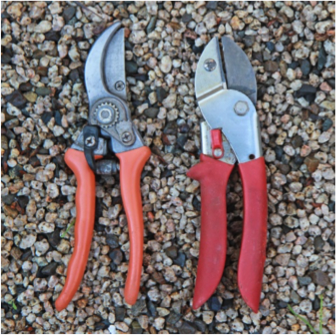Get Garden Tools in Shape

by Jodi Bay
Winter is the time for gardeners and the garden to rest. During this slower gardening period, take the time to check and prepare garden tools for the tasks that begin in spring. Repairing, cleaning, and sharpening garden tools now will make them easier and safer to use plus preserve your investment.
An annual inspection of gardening tools is recommended to keep them in working condition. Begin by determining if the handles need repair, and if the tool is sharp and sturdy. Wood handles can be revived by cleaning, gentle sanding and rubbing on boiled linseed oil. Apply a coat with a rag and let dry for 5 to 10 minutes and reapply until the wood no longer absorbs the oil. Let cure for 8 hours. Always wear gloves when working with chemicals. If the handle is cracked, look for a replacement handle. This is often less expensive that purchasing a new garden tool.
Remove any rust with a wire brush. If the rust is significant, soak the tool in pure vinegar for a few hours to overnight, depending on the need. Brush off the remaining rust with a wire brush or steel wool rated 000 or 0000. Repeat if needed. The best way to prevent rust is to always dry tools prior to storing. Laying them on a warm surface in the sun for a couple hours will suffice. Additionally, coating steel surfaces with household oil also helps prevent rust.
 There are two types of pruning mechanisms: bypass and anvil. A bypass pruner cuts when one blade 'passes by' the other. Anvil pruners cut when the blade presses against a flat lower plate. Bypass pruners are the preferred tool for pruning live plants while anvil pruners work best when cutting dry plant material.
There are two types of pruning mechanisms: bypass and anvil. A bypass pruner cuts when one blade 'passes by' the other. Anvil pruners cut when the blade presses against a flat lower plate. Bypass pruners are the preferred tool for pruning live plants while anvil pruners work best when cutting dry plant material.
To inspect pruners, look at the blade. If there are divots or nicks, the tool might need to be professionally sharpened. The divots are the result of pruning a tree or shrub that is too big for the tool. Typically, hand pruners can cut wood with a diameter of ¾ inch while loppers can cut up to 1 ½ inches. For branches larger than 1 ½ inches, use a pruning saw or a rope saw. Check the pivot on the pruning tool for smooth motion and wobbliness. Tighten if needed.
Once the tools are inspected and the maintenance is complete, follow the process created by Ben Kotnik of Suburban Food Farm. Ben says "To help in remembering the steps for tool care, use this acronym: Scrub - Sharpen - Sanitize or S-S-S. It is good practice to implement Scrub - Sharpen - Sanitize every time garden tools are used and between pruning plants."
The first step is to Scrub the tool. Remove debris from the tool with soap, water and a gentle scrubbing pad. A foaming bathroom cleaner is also effective. Tools accumulate sap when pruning which can 'gum-up' moving parts and leave residue on the cutting blade and anvil. Additionally, fertilizers or other chemicals are corrosive. Regularly cleaning tools ensures improved performance and tool longevity.
Sharpening tools makes using them easier and safer. Cuts will be smoother and there will be less torque on your hands, wrists and arms. Also a cleaner cut is better for the plant and a sharp blade is safer for you should you be cut.
UCCE Master Gardener from Santa Clara County, Allen Buchinski, a garden tool specialist, explains "If you are not comfortable sharpening the tool, or if it is very dull or nicked, find a professional tool sharpener to do the work. If you choose to do it yourself, a variety of sharpening devices are available. Options include carbide sharpeners, whetting stones and diamond hones. Pick one that works for you. Sharpen the bevel of the cutting blade on one side and in one direction, from pivot to point, maintaining the original bevel angle. A tip is to use a marker to color the bevel and then sharpen until all the color is evenly removed. For anvil pruners, sharpen both sides of the blade."
For shovels, hoes and other non-pruning tools, sharpen if the metal has folded back. Use a flat edged file or a coarse sharpening stone. Using a vise to hold the tool as you file is helpful. Take tools with serrated edges, such as a pruning saw, to a professional for sharpening.
Sanitizing garden tools prevents transmission of disease from one plant to another. It should be done prior to pruning and always between pruning plants. Dip the tools in a 10% bleach solution (1 part bleach and 9 parts water) and let dry. Tools should never be put away wet. Alcohol wipes also work for sanitizing tools while in the garden as well as alcohol-based disinfectant spray. Lastly, oil any joints, blades or metal parts with household oil such as 3-in-One. This helps to maintain smooth motion for tools with pivots and reduce rust while in storage. Wipe excess oil with a rag and ensure that all the metal surfaces are coated.
Clean, sharp and sanitized tools make gardening easier and safer, protect your investment and reduces disease transmission. Start the new year and spring gardening with well cared for garden tools. Your plants will thank you.
Jodi Bay has been a UCCE Master Gardener since 2012. Her love of gardening came from time spent gardening with her father in her childhood home. Jodi specializes in teaching new gardeners how to grow their own food and leads a group of other Master Gardener tool enthusiast in sharing knowledge on tool care best practices.

